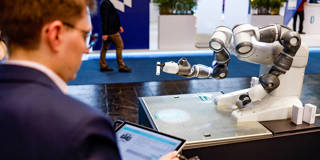As artificial intelligence reduces demand for labor and boosts productivity, governments and businesses are going to have to adjust. While governments might want to raise taxes and redistribute the revenues in order to mitigate the short-term disruption, in the long term, they will need to think bigger.
LONDON – In April, Alphabet CEO Sundar Pichai predicted that artificial intelligence would have an impact “more profound” than any other human innovation, from fire to electricity. While it is impossible to know precisely what that impact will be, two changes appear particularly likely: demand for labor will fall, and productivity will rise. In other words, we appear to be moving toward a labor-less economic model, in which fewer human workers are needed to sustain growth.
Jobs in back-office support, legal services, and accountancy seem to face the most immediate risk from new generative AI technologies, including large language models like ChatGPT-4. But every sector of the economy is likely to be affected. Because language tasks account for 62% of employees’ time, a recent report by Accenture notes, large language models could affect 40% of all working hours.
Accenture estimates that 65% of the time spent on these language tasks can be “transformed into more productive activity through augmentation and automation.” And a new McKinsey report predicts that the AI-driven productivity boost could add the equivalent of $2.6-4.4 trillion in value to the global economy annually.

LONDON – In April, Alphabet CEO Sundar Pichai predicted that artificial intelligence would have an impact “more profound” than any other human innovation, from fire to electricity. While it is impossible to know precisely what that impact will be, two changes appear particularly likely: demand for labor will fall, and productivity will rise. In other words, we appear to be moving toward a labor-less economic model, in which fewer human workers are needed to sustain growth.
Jobs in back-office support, legal services, and accountancy seem to face the most immediate risk from new generative AI technologies, including large language models like ChatGPT-4. But every sector of the economy is likely to be affected. Because language tasks account for 62% of employees’ time, a recent report by Accenture notes, large language models could affect 40% of all working hours.
Accenture estimates that 65% of the time spent on these language tasks can be “transformed into more productive activity through augmentation and automation.” And a new McKinsey report predicts that the AI-driven productivity boost could add the equivalent of $2.6-4.4 trillion in value to the global economy annually.